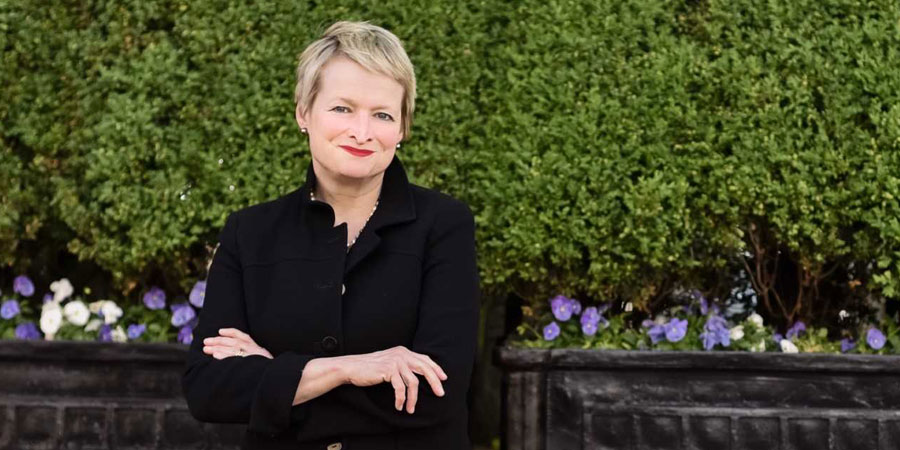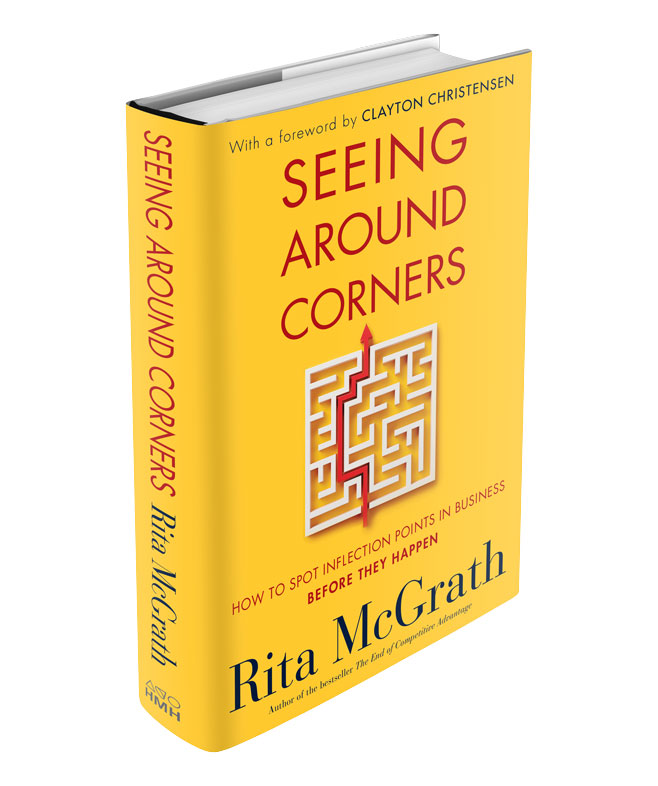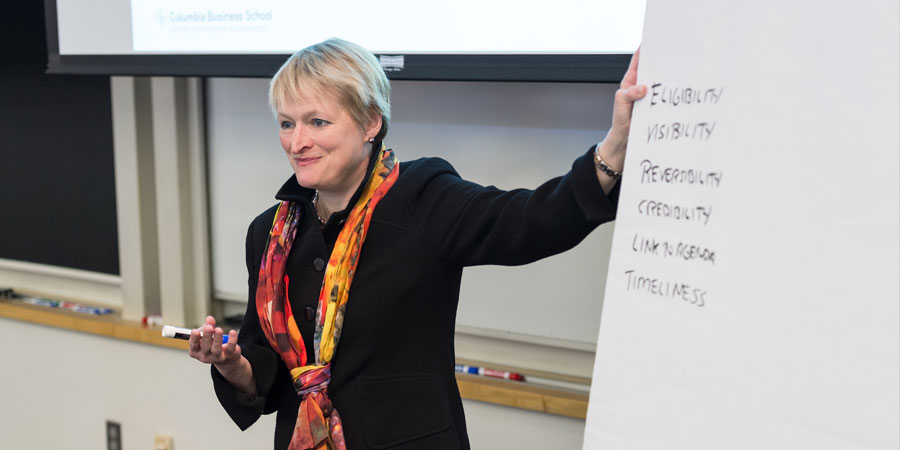Many hats. Professor at Columbia Business School, Best Selling Author( with 5 books till date), a highly sought after Speaker, regular Columnist in HBR. Multiple accolades including #1 for Strategy by Thinkers50. All of the hats seem to sit very comfortably. Presenting Rita McGrath, one of the world’s top experts on innovation and growth and management thinker par excellence. Here, in a freewheeling interview with BrandKnew, published by ISD Global, she unravels on her work and life and importantly on her new book out this month ‘ Seeing Around Corners ‘.
BK: Tell us a bit about your growing up years.
RM: I was born in New Haven, Connecticut. When I was about eight, my family moved to Rochester, New York. My parents were both scientists. And I think that really informed a lot of what I experienced growing up.
I left Rochester to go to Barnard College in the late 70s. At the time, Columbia University was not yet co-educated. So there was a lot of discussion about the role of women’s education and where women could master their professional identities. Barnard was and still is an all-women’s college.
When I was child, I thought I might be a journalist, I thought I might be a lawyer. I read a lot. I was in the library all the time. The people that inspired me were mostly, I’d say, business leaders. My mother was a microbiologist—and I think her dedication to that field really had a lasting influence on me.
BK: What caused you to look at Entrepreneurship, Innovation & Strategy as areas to master your craft in? And how has the journey been thus far?
RM: I came to look at entrepreneurship, innovation, and strategy somewhat by accident. My first job out of university was with the City of New York. We were actually right at the forefront of the digital revolution; we were beginning to put together the very first purchasing system that went from paper to digital processing. As a consequence, I got to see large-scale organizational change firsthand. I was accepted to the Wharton School’s PhD program some years later, and joined the Entrepreneurship Center, which at the time was being run by Ian Macmillan.
I had this idea of studying what I call the science of implementation. Mac said he couldn’t think of anything more boring than the science of implementation. So he asked, “Well, have you thought about it more in terms of corporate entrepreneurship?” And so that’s where the two streams really came together. As I’ve worked in the field now for many, many years, it’s just struck me as endlessly fascinating. I would say that the field of strategy is now really becoming merged with the inquiry around innovation; I don’t think you can talk about strategy these days without talking about innovation. And increasingly, you can’t talk about innovation without talking about some aspect of digital. Although it wasn’t some grand plan at the time, you can see how the arc of my work brings it all together.
BK: Did you always want to be a writer? When did the writing bug bite you? Or you see this as a natural dovetailing into your teaching, consulting, speaking practice?
RM: Well, I always loved to write. I kept a journal as a child. As I said, I thought of becoming a journalist.
And I find that writing is so instrumental to thinking. I’m always struck by colleagues who say, “Oh, well, I don’t write my own books. You know, I have the ideas, but other people do the writing.” And I just don’t understand that. I don’t think I could do the thinking that I do without actually being immersed in the writing. So I think it’s super important.
BK: In an era of ‘ Conformity, compliance, adherence, standardisation ‘ and all of that, do modern day organisations really see Innovation & Entrepreneurship as assets ? Or you see this more the exception than the rule?
RM: I think they do. I think that on a theoretical level, everybody understands that if you don’t create your future, and you don’t invest in your future, you’re not going to have one. I think that’s not controversial anymore.
But I think where corporations struggle is the trade-off between what are we investing in today, versus what’s necessary to make a bright future. And I think it’s just too easy to give in to short-term pressures, and to do what’s known and what’s understood, as opposed to going into the very uncertain and different possibilities in the future. So I think organizations really do see entrepreneurship and innovation as assets, but actually acting on that insight proves to be more difficult than many of them think.
BK: In our practice at ISD Global with brands and organisations, we have been espousing the value and impact of ‘ intrapreneurship ‘ – what would your thoughts on this be? Are they walking the walk?
RM: Intrapreneurship is absolutely critical. If you think about the theory of the growth of firms, the actions of individual leaders and individual managers to expand the reach of their firms is absolutely essential to corporate health and to the way that companies discover their future. If all you do is execute against today, you end up with really disappointing results.
The poster child at the moment is probably General Electric, which for many years had a world-class reputation for innovation and growth, and yet, in the last 10-15 years, has really stumbled delivering on the promise of that. A combination of taking a lot of resource out of the company through stock buy-backs and a big bet on fossil fuels as the world is moving toward renewable energy have led them to their current struggle to remain relevant.
BK: Would you want to elaborate more on Discovery Driven Planning? Your book ‘ Discovery Driven Growth ‘ articulates that as well I reckon?
RM: Discovery driven growth and discovery driven planning are ideas that I’ve been associated with for a long time. Discovery driven planning was developed to help organizations learn to understand new areas. One of the distinguishing characteristics of new spaces is that the ratio of assumptions that you have to make, relative to the knowledge that you have is very large.
What I think is different today is that we used to have this very clear distinction between the core business and the new ventures. The core was all about effective execution, and it was very predictable—you had a platform of experience that you could build on. And then the new businesses were the things that were unpredictable and uncertain—a lot of learning and discovery had to happen. I think the new perspective I have on discovery driven planning is that it is now relevant to a lot of the challenges that people are facing right in their core businesses. So as digitization, and as whole new kinds of competition are emerging, what we’re finding is that the techniques that are suitable for new ventures are actually becoming more suitable and more important in the core business.
BK: Is Innovation an over used word and under implemented practice in organisations? If so, why do you think that is the case?
RM: It’s one of those words that people slap on a lot of things. It’s like “strategic,” right? Strategy has come to mean anything important. So now we have “strategic human resources” and “strategic procurement.” And I think innovation is now representing anything from a little twist to our forms management system, to massive investments in new market creation. So I do think the word has gotten to be overused. I think there are very few common definitions. And when I look at the state of the art, in terms of innovation management practices, it’s still pretty primitive. You know, a lot of organizations talk about it a lot. But it’s what I would call “innovation theater.” People are spending time on it, but it’s not really implemented in a way that shapes the trajectory of the organization.
BK: What was the motivation behind writing the book ‘ Seeing Around Corners ‘ and what has been your enrichment from that? Are we ‘missing the wood for the trees’ ?
RM: Back in 2000, I wrote a book called The Entrepreneurial Mindset. And that was followed by various perspectives on how organizations can discover new opportunities and unearth new challenges.
My last book was called The End of Competitive Advantage, which basically said, in many cases, what had been given as the tools for creating competitive advantage no longer apply. What started to become a pressing question for people was: Well, how do you know when the right time to take an action is? You don’t want to move too early, because then the ecosystem isn’t ready. And you could be a first mover without being able to really capitalize on your investments. But you also don’t want to leave it too late, which is to get to the point where everything around you has already happened and there are few opportunities left. So that was the real motivation behind it.
I’d say the triggering event was reading a fantastic article about how long things take to actually make a change in the world. That got me thinking about the gestation period for strategic inflection points—and the realization that they actually often take a really long time, from when the first trends become clear to when they actually have an affect on your businesses. I’d also always been an admirer of Andy Grove and his work on strategic inflection points. So this is a natural follow-up to that.
BK: You make a strong debate about Competitive Advantage V Cumulative Advantage- are you putting your neck on the line to say RIP Competitive Advantage?
RM: If you look at your core people, your core strategies, things that are your core capabilities, those can be long lasting sources of competitive advantage. I think what I was trying to signify in that book was that the conventional way we thought about competitive advantages as attractive positions in an attractive industry, that you throw up entry barriers like crazy and defend them to the death, that that really didn’t fit with the way competition behaves today. Things are getting faster, technologies are moving more quickly. And when you think about competitive advantages, we can’t do it the same way we did historically.
BK: We are seeing a definite shift in consumption behaviour patterns from ‘ ownership ‘ to ‘ experiences ‘- in your understanding, are brands and organisations seeing and adapting to this tectonic shift?
RM: I do think organizations are trying to adapt to this shift. I would say incumbents struggle with it more than new entrants. And a lot of the new entrants are really benefiting from this move. So we’re seeing entirely new business models around things like furniture as a service, people buying experiences rather than buying products and services.
BK: In your teaching role at Columbia Business School, what trends do you see that stands out among potentially tomorrow’s future leaders?
RM: I think the agenda has really changed. I think we’re seeing a lot more interest in diversity and inclusion as part of leadership characteristics. We’re certainly seeing a lot more demand on the part of our students for companies and organizations that have more of a purpose. People want to feel that their effort and actions mount up to something. And so I think that’s going to create a sea change in what people both give as leaders and what they expect as leaders.
BK: In the marketing, branding world of today, there are some strong rants going around about ‘ demographics being dead, it’s now about addressing mindsets ‘- what would your views on this be?
RM: I would absolutely agree. I think the fact that you’re using demographics to predict your market needs is not a very satisfying way of looking at things. Instead, the perspective I really like is Clayton Christensen’s “jobs to be done” theory, which is basically saying: think about products and services not so much as things that are bought, but things that are hired to get jobs done in people’s lives. And if you think about that, it changes your perspective on what you’re doing and who you’re selling to—and how they are operating.
A colleague of mine who works for a big retailer was saying, “Well, customers don’t behave the way that they’re supposed to. I have grannies in the store looking at prices on iPhones.” In a way, that’s a very illuminating comment, because it says that the behavior is what I need to understand not so much the demographics.
BK: If the customer is an infidel( going to the cheapest driven by price loyalty), would customer loyalty remain at the vanguard of a brand’s quest?
RM: The perspective on what your customer is looking for is really going to be a function of how you strategically have chosen to deal with customers. Certainly, you’d like to have loyalty, certainly you’d like to have customers habitually buying from you. And if you think about it, from a customer’s point of view, always trying to look for the cheapest and the most readily available and so forth, it’s effortful. Ideally, what you’d like is sort of what Amazon’s created, which is the ability to be a default choice.
BK: Could you tell us about the books and people who have inspired your life and career?
RM: There are so many, it’s hard to hard to name some. In the world of fiction, there are many women writers who I thought were just fantastic people. I was at one point an avid consumer of Agatha Christie and Dorothy L. Sayers novels.
In terms of business writers, I read a lot of Peter Drucker. He was very informative to me. As I was joining my PhD program, I was assigned by my Organizational Behavior professor to read one of his books each week, so it was a bit of a crash course. And I would say Drucker still remains a real inspiration in terms of understanding the deeper patterns that people live by.
BK: What makes Rita Mcgrath go ‘ Wow, another day at work ‘ ?
RM: I love my job, interacting with people, learning about new things, seeing new and interesting phenomena, having the time to think. Those are all things that I find really motivating.
BK: What do you do in your spare time? Your leisure time pursuits?
RM: I do a lot of reading of various types. I go to the gym. I enjoy spending time with family. I do love cooking and experimenting with new recipes – it’s satisfyingly tangible when so much of my life is intangible. A nice sharp knife and something healthy to eat are very satisfying.
For a long time, I had kids at home and a full-time job and a very demanding research agenda. So I’m afraid it didn’t leave too much time for leisure time pursuits. I would say I do very much enjoy things like visiting new cities and seeing what the life is like there. So those would be some of the things that I really get a kick out of.
–
Seeking to build and grow your brand using the force of consumer insight, strategic foresight, creative disruption and technology prowess? Talk to us at +9714 3867728 or mail: info@groupisd.com or visit www.groupisd.com



